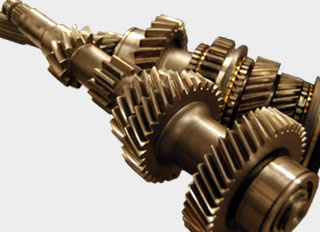Most people know it’s important to regularly change their car’s oil – the engine’s oil, that is. But many forget (or just don’t know) that it’s as important – for the same reasons – to periodically drain and change the “oil” inside their car or truck’s manual transmission.
I put “oil” in quotes because technically, it’s not oil – it’s gear lube. Or, in some cases, automatic transmission fluid … yes, in a manual transmission; bear with a minute, I’ll explain below. But either way, it serves the same purpose: To lubricate moving parts, to dissipate heat and to keep abrasives and contaminants away from tightly-fitted, moving (and meshing) metal parts.
Over time, the lube (or fluid) begins to break down, or becomes suffused with contaminants. It loses its ability to lubricate and protect the gears gnashing together (at high speed) inside your transmission. You may begin to notice a degradation in shift action; it gets a little harder to change gears, for example. The action feels sticky or tighter – especially first thing in the morning (and especially when it’s cold out).
Fuel economy may dip some, too.
What’s happened is that friction has increased – and friction in the context of meshing gears is not desirable.
Regular fluid/lube changes will help keep the gears meshing as they ought to. That is, smoothly. And this, in turn, will help the transmission last longer.
You’ll want to consult the service schedule for your particular vehicle, but generally, the changeout interval is about once every 50,000 miles or five years – whichever comes first.
Another side benefit of doing this service is you’ll be more likely to notice low gear lube/fluid levels before the box runs dry – or so low that a catastrophic failure occurs. Remember: Manual transmissions – unlike automatics – usually do not have dipsticks. The only way to check the lube/fluid level is to take out the fill plug – usually located on the side of the transmission case. If lube/fluid just barely trickles out of this hole, the box is properly filled. If it does not, you will want to add the correct type of lube/fluid until it does trickle out of the fill hole.
Speaking of which. Before you drain – or fill – anything, be absolutely certain about what you plan to put in there. Most older vehicles with manual transmissions (and many modern ones) use – as you’d expect – manual transmission gear lube, which looks (and pours) a lot like motor oil. But some manual transmissions specify automatic transmission fluid (e.g., GM Dexron III). Be sure you know what your car wants – what it needs – before you proceed.
Ok.
You will need:
A jack to raise the car.
Jack stands to support the car.
A catch pan for the old fluid (disposable aluminum turkey roasting pan works great).
A can of PB Blaster penetrant.
A breaker bar.. leverage, son.
A 1/2 drive or 3/8 drive (depending on your vehicle) extender bar. The squared-off end fits the typical fill/drain plugs perfectly.
The correct type ands quantity of gear lube or ATF.
A length (about 8 inches or so) of flexible rubber fuel line (I’ll explain in a minute).
Old clothes.
About an hour of your time.
First, get the car on flat – and solid ground. A concrete driveway or garage pad being ideal. Raise it enough to give you reasonable wiggle room underneath and then use the jack stands to support the weight of the vehicle. Do not rely on the hydraulic jack by itself. Hydraulic jacks can fail – and if you’re underneath the vehicle when that happens, you’ll be very sorry that you didn’t spend the extra five minutes to put the jack stands in place.
Now crawl under, eyeball the transmission case. You are looking for the drain plug – which is usually on the underside/bottom of the case – and the fill plug, which is usually on the side of the case. Once found, spray both of them down with the PB Blaster and let ’em sit for about 5-10 minutes. This stuff is the aerosol equivalent of duct tape and a true friend to the home mechanic. It makes loosening and removing long-undisturbed bolts a lot easier.
Now, take the socket extender (you may need a “shortie” or a mid-sized or a longer length, depending on the wiggle room available; buy the size you need at any Sears or Northern Tools, etc.) and fit it into the recessed square hole of the fill plug.
Do not remove the drain plug first!
Learn from other’s experience, young Jedi.
Here’s the why: If you remove the drain plug, the old lube/fluid will drain out. Great, right? Yes. Unless you can’t get the fill plug out. Which happens. And then, friend, you’ve got a problem.
Always remove the fill plug first.
This will also let you check the current fluid level inside the case, which is good to know even if you’re about to do the drain and change. If it’s low, you may have a leak someplace. It’s a sign that you ought to check the level again in a month or so. Not forget about it for the next four-five years.
You will likely need a break bar (or long ratchet) for leverage as these plugs are often really tight. Apply steady, even pressure. Be sure your extender bar is fully seated in the plug and try to keep inward pressure on it as you use the breaker bar/ratchet to loosen it. Once it begins to turn, the rest will be easy.
With the fill plug out (set aside someplace, make sure not to lose it) take out the already loose (right?) drain plug and let the old fluid/lube drain completely. Go have a cup of coffee or a beer. Give it ten minutes, at least.
Now, reinstall the drain plug. I coat the threads with anti-seize compound (same stuff you use on spark plug threads) to make the next time easier. Be careful not to overtighten during the install. Remember: Most transmission cases are made of aluminum and aluminum is fairly fragile. Don’t be a meathead. A quarter to half turn more from fully seated is plenty.
Now, the last part – refilling the case.
I like to use those long slender quart barrels that gear lube typically comes in. If your car’s transmission specifies ATF, you may still want to get one of these long, slender plastic quart bottles. Why? Because you haven’t (probably) got a hydraulic gun to shoot the fresh lube/fluid into the transmission’s fill hole – the way a shop would. You will be doing it by hand, by squeezing the fluid into the hole, via the bottle.
Here’s where that length of fuel line hose comes in.
Use scissors to cut off the tip of the bottle’s screw-top nipple. Push one end of the hose onto the nipple. Now you, the bottle and the hose get under the car. Insert the other end of the hose into the fill hole on the side of the case and squeeze as much fluid as you can into the transmission. Now, carefully remove the hose from the fill hole, slide out from under, refill the bottle with fresh fluid/lube – and repeat.
Do this until you’ve filled the case to the specified level – which you’ll be able to tell you’ve done once fluid/lube begins to dribble (not gush) out of the fill hole.
Reinstall the fill plug.
You’re done!
If you value independent media, please support independent media. We depend on you to keep the wheels turning!
Our donate button is here.
If you prefer to avoid PayPal, our mailing address is:
EPautos
721 Hummingbird Lane SE
Copper Hill, VA 24079
PS: EPautos stickers are free to those who sign up for a $5 or more monthly recurring donation to support EPautos, or for a one-time donation of $10 or more. (Please be sure to tell us you want a sticker – and also, provide an address, so we know where to mail the thing!)











My ancient Volare’s 4-speed transmission also requires ATF. As my mechanic brother once remarked, ATF is weird stuff.
Changing fluid on that A833 trans is a real pain, as the filling area is cramped. I used a set-up much like yours, but to get the transmission level I parked the car across a ditch.
That business about the gears crunching when the lube is cold applies to NEW, SUFFICIENT lube at least as much as to old, or insufficient fluid.
Telling people to make anything of stiffness/crunching in cold lube is actually telling them somewhat less than nothing. It could mislead, though not in a way that would DAMAGE anything.
By the way, the transaxle (hypoid lube specified) on my 1966 Corvair has NO drain plug, and NO change interval (but yes, a check interval). I use Redline hypoid lube.
Two other things,
1. If your drain plug has a washer make sure you put it back. And, if it’s an aluminum “crush” type it’s a good idea to replace it.
2. Eric, if you’re getting paid by PB Blaster you may want to delete the next paragraph. I saw an engineering paper several years ago that compared several loosening liquids, WD40, Kroil, another name brand(it might have been PB Blaster, I don’t remember) and a 50/50 mix of automatic trans fluid and Acetone. On a rusted nut that with nothing would require 500 lb ft of torque to loosen the WD-40 took it down to around half that, PB(?) and Kroil were about the same at 150 ft lobs and the 50/50 mix was about 50 lb ft. I’ve used this almost exclusively since then and it even worked on removing a crank pulley that someone had used red loc-tite on.
Coca-Cola used to be good for that also, but they’ve reduced the phosphoric acid content.
Hi Mark,
I swear on a stack of SD-455 connecting rods that I never shill for a product in my articles. Ever. I sometimes mention stuff I use personally and like and therefore recommend. That’s it. No checks coming my way from PB Blaster!
What about brake fluid? That stuff will eat paint, so why not rust?
Eric,
That wasn’t a criticism. In fact, I hope you do find a funding source such as that if it fits with your page. there’s no shame in representing a brand you believe in and if they pay you for your kind words, good for you. Now, if you’re only saying kind words because they pay you…THAT’S a different story.
Eric, your fuel hose method is good, but this is better:
http://www.acehardware.com/product/index.jsp?productId=1272832
Just remember to clean it after use or the oils wreck the hoses and dont use it below 32 degree air or fluid temperature. It is totally worth the money for time saved and messes that dont need to be cleaned up. It handles all kinds of fluids for your vehicle and other projects.
Anchar, I have a pump I paid about $10 for that has long hoses(clear vinyl) I can use to drain or fill. It’s long plunger with a port on each end. I can fill a gearbox with a bucket on the floor or drain one and pull the hose off the pump allowing it to continue siphoning. You can weight the end in the gearbox so it stays on the bottom if your drain hole is on the side.
I had a transfer pump that used a hand drill and it worked well till somebody toasted it. It had threaded ends for hoses and worked well as long as you kept the rpm to a decent speed, the very thing i’m sure that killed it. i’ve had a couple friends you’d just as well give them something as loan it to them. No, you can have it, keep it, I have another……and then go buy something else or another one like you gave them. If it’s ever mentioned again, it will be because they say something like Remember that pump you gave me? That thing just quit.
I gave one of these guys a new in box high dollar buffer I intended to use on my El Camino I had painted with Imron….that old cheap stuff.
I know there are plenty of cheaper pumps out there, but I bought this one to fill my truck from a 55 gallon barrel of diesel I had stored, so I needed one that would not quit so easy. I had a cheaper one but it crapped out on me after about 10 gallons of pumping. Plus it is not just for the car….I use it for all sorts of stuff. If it is taken care of, it should last a long time- it does siphon too.
Anchar, I simply use a 12 V fuel transfer pump of the high volume diesel type. You can use battery clamps or just wire in directly to a 12 V source. In my experience, they don’t ever wear out pumping diesel. Seems like they cost about $100, last forever and fill a diesel tank toot sweet. I filled a dozer off a drag up tank in the bed of a roustabout truck today and it took only a few minutes. 100 gallon nurse tanks in the back of light trucks are fairly much a given in this part of the country. That red diesel for equipment flows into your road truck just fine…….just sayin……just fuck em and feed em fish heads. I screw the gummit every chance I get……at least a couple times a day. The whole bunch can KMA.
that’s just another version of a peristaltic pump. the hose(s) shouln’t be very difficult to change out if they go bad. the ones I use are motorized and have a quck change head for use with disposable tubing that costs around $.09/foot.
Well I’ll be a monkey’s uncle. That pump appears to be identical to one I’ve used for many years. It was made in Minnesota and the company is long out of business. It is an excellent hand pump–once you get the siphon started, you step back and let it go.
Thanks for the tip in case I ever need to replace mine.
Some new cars apparently don’t require ATF replacement. For example, 2004 Kia Rio manual does not specify ATF changes and according to Kia, does not need an ATF change. This is the case with many newer cars.
Hi Orville,
Yes – but beware.
They do this for advertising purposes; to give the impression that maintenance costs are lower (or nonexistent).
In fact, in reality, oil (and other such fluids, including ATF) inevitably degrades over time. As it degrades, the protection it provides diminishes… also, contaminants will continue to build up and – eventually, inevitably – the medium (the oil/ATF) will no longer be able to effectively keep these contaminants held in suspension, away from vital parts…
Just FYI –
Yeah, that’s a very old trick. To quote from my 1972 AMC owner’s manual’s maintenance schedule section:
“Automatic transmission: For cars in all regular uses, NO maintenance is required except fluid checks.”
Yeah, right, if anyone believes that I have a bridge in Brooklyn I can sell you! (Are you listening, Clover? I’ll give you a great deal!)
I’ve changed the fluid and filter in mine regularly and the transmission (actually a Chrysler Torqueflite) has needed no repairs in over 40 years of use.
Hello Eric,
I certainly agree with you, fluids degrade and need to be changed. I’ve done ATF changes on several cars in the past. I wonder about the legal exposure of automakers if they tell people in the owner’s manual not to change the ATF (not explicitly, of course, but not mentioning it in the service schedule). Do you remember the issue with sludge in Toyota engines? This happened because they wanted to increase the interval between oil changes (I think, as you correctly mentioned, for the marketing purposes), which has created a big debacle and they had to deal with several class action lawsuits. Another question – even if you want to change the ATF, what is the right kind, since it is not mentioned in the manual? I suppose, one can dig around (asking the mechanics in the dealership and so on) and find out the right one.
Hi Orville,
Well, technically/legally speaking, so long as there are no failures that can be attributed to lack of (or insufficiently regular) maintenance during the warranty period, they – the car companies – can wash their hands of it if a problem crops up later.
Now, of course, if problems of that kind do crop up it will ultimately redound to their detriment as word will get out.
As far as what fluid to use: It ought to be easy enough to determine what the factory fill was (e.g., Dexron III/Mercron) and it may be that there is a stamping on the dipstick or impressed on the fill tube that tells you what to use.
I would think the manual would have to tell you what to ADD if it got low.
eric, thinking back, waaaayyy back, seems like in my youth oil advertisements were replete. But now I guess you’d have to watch tv to see one except for automotive mags. No billboards proclaiming the benefits of XYZ oil. Or am I just out of the loop?
Seems like the only time I notice anyone shilling oil is on an ad for a new car and they mention ” free lifetime” oil changes…..or till you trade it next year for the new model. I wonder if anyone has ever tried to negotiate a new car price without the “free” oil changes? Wouldn’t it be worth a few hundred dollars you could put toward Amsoil and filters? I know I’m a dinosaur when I mention changing the oil and filter and the young guys I work with, who might spend an entire day changing oil and filters on equipment, make an appt. for their truck(pickup).
Sometimes the shop manual will call out teflon pipe tape instead of anti-seize compound. The teflon tape will seal the threads while the anti-seize isn’t meant to that. Both of course will make it easier to take apart.
BrentP, the most impressive thing about my Nissan pickup was the light blue sealant/threadlocker on everything. I never found so much as a screw that didn’t have what appeared to be the same thing that was on the transmission, between the pieces of the housing and transfer case and between those pieces. Even the horn button screws had it. It was good stuff. Nothing ever worked its way loose or leaked.
Before I got too decrepit (and lazy) to change my own oil, I used to take advantage of the slope in my driveway so that the car was level when the front end was up on stands.
Great article and good videos Eric, that hose trick is brilliant. A little suggestion an old mechanic taught me many years ago. Keep a large piece of cardboard around for working under cars (an unfolded radiator box works perfectly). It lets you slide in and out easily without taking up the extra inches of a creeper, works on hard surface or sand, and will keep your driveway clean if you slop some fluids out of the catch pan. Love the site, keep putting out great content like this!
Thanks, Kevlar – and, great tip in re the cardboard!
Kevlar, I’ve used that many times. I like to keep a cheap plastic tarp folded up in the vehicle for doing that when you don’t expect it. I took a virtually new crosstie, cut in half with a chainsaw at an angle that was easy to drive on. Fast oil change or looking at anything underneath. I used to keep them shoved together and park a pickup over them. I’d still be using them but a friend notorious for losing everything he borrowed, borrowed those. I eventually found ONE. Not sure why I haven’t made others. I have lots of crossties and even the big timbers…..and a Stihl chainsaw.
I needed to change in engine in 1980 and had a garage with 8′ ceilings so I built a 3 piece A-frame with 2 3/8″ upset tubing and used 2 7/8″ tubing to make the ends the center portion would slide into. I welded nuts on the big tubing with bolts so I could make it from about 7′ to 12′ wide. I can remove the crossbar that’s gusseted with sucker rod and have 3 pieces that you can haul in a pickup. I’ve set it up in many places for different things. I used it and a 2 ton chain hoist to load 3,000 lbs concrete pads. I use it to hang animals for processing. Now that you can buy ready made pipe caps, use a couple for the ends of the cross piece since mine are open and leaning against it or having something bang on it during most of the year can have you fighting a few hundred wasps(hep, hep). I’ve loaded just about everything with it, even my Lincoln 200 SA redface welder. I’ve used it to load one trailer on another. If it’s a southern engineering thing, I have probably used it or still have it. If anyone’s interested in making an A-frame like that let me know and i’ll give you exact instructions.
Great write-up! One question I have that has kept me from doing this so far: I have nearly 200k miles and am 99% sure the clutch has never been replaced; am I wasting expensive gear oil (and my time) doing this if its all gonna come out when the clutch is eventually (possibly sooner than later) replaced? Thanks!
Ryan… You should have no worries…. TYPICALLY you should have no problem R&R trans /clutch without opening any of the fluid holes…
Eric… At my local car parts store they sell a hose/funnel with a threaded fitting on the end that’s just right to screw onto a quart of trans fluid or oil
Hi Ryan,
Absolutely not!
A clutch is about $300-$500. Rebuilding a transmission twice that, easily.
Assuming no abuse – and proper maintenance – a decently designed manual gearbox should last several hundred thousand miles, easily.
And: Your clutch might be ok for another 50,000 miles. Maybe more.
It happens…